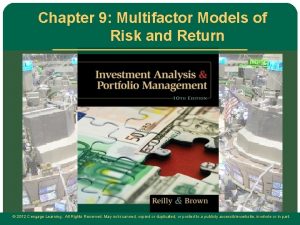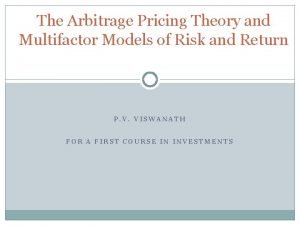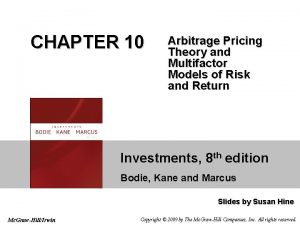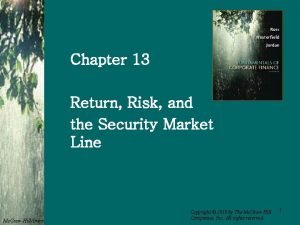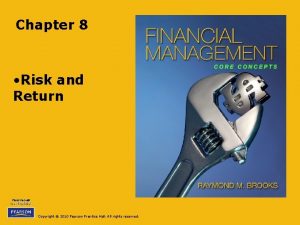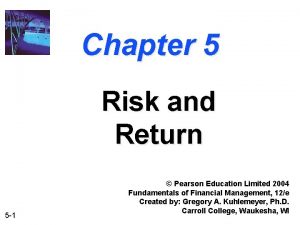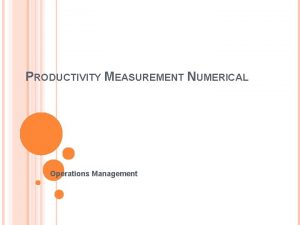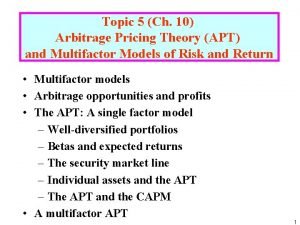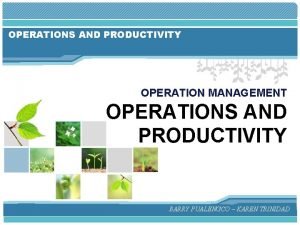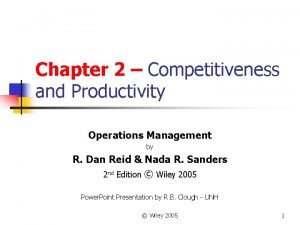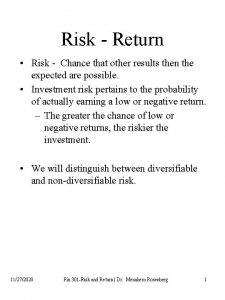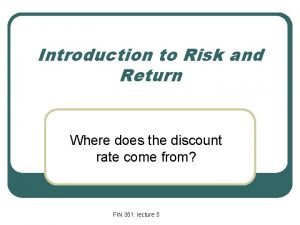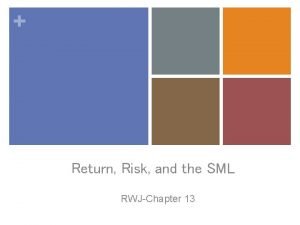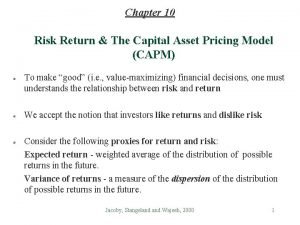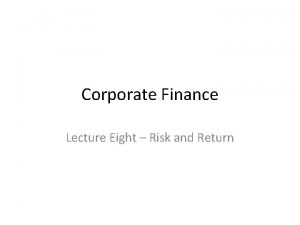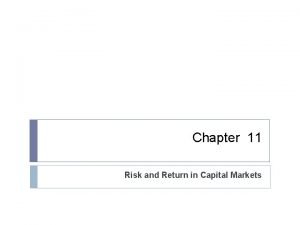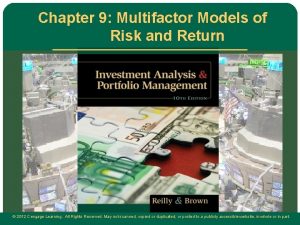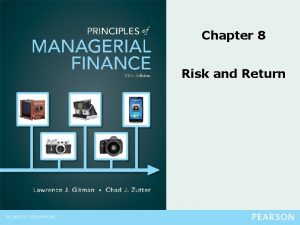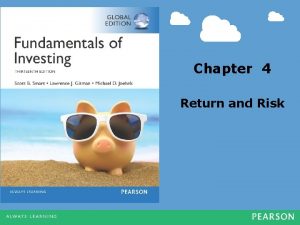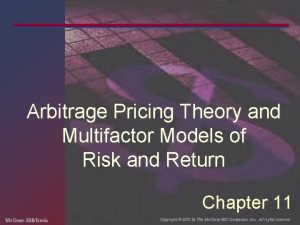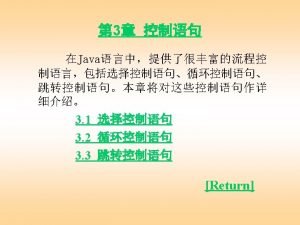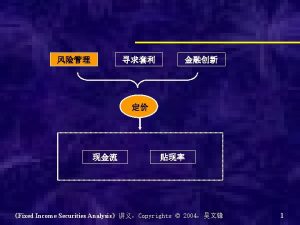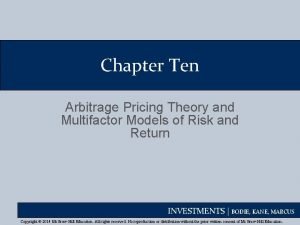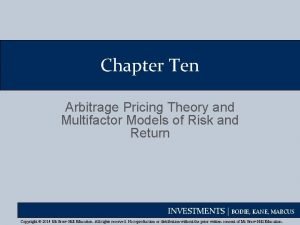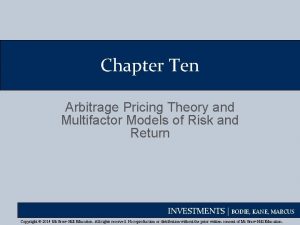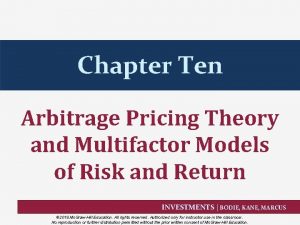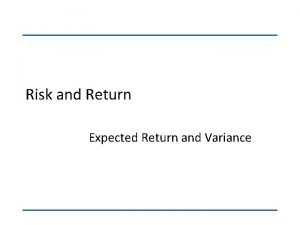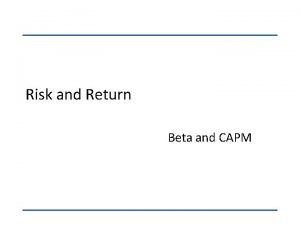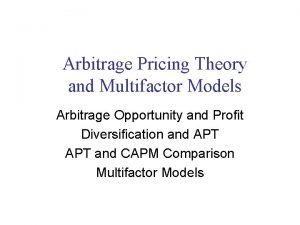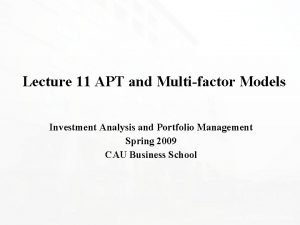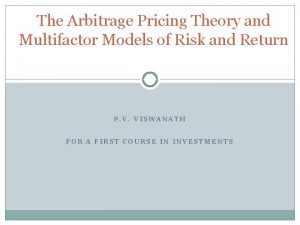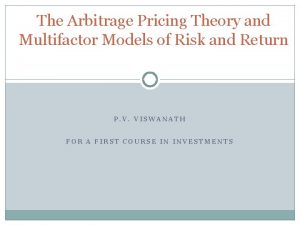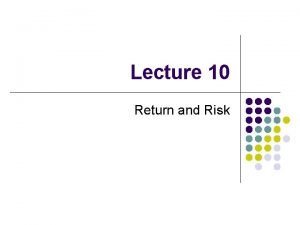Chapter 9 Multifactor Models of Risk and Return

























- Slides: 25

Chapter 9 – Multifactor Models of Risk and Return Questions to be answered: • What is the arbitrage pricing theory (APT) and what are its similarities and differences relative to the CAPM? • What are the major assumptions not required by the APT model compared to the CAPM? • How do you test the APT by examining anomalies found with the CAPM?

Chapter 9 - Multifactor Models of Risk and Return • What are the empirical test results related to the APT? • Why do some authors contend that the APT model is untestable? • What are the concerns related to the multiple factors of the APT model?

Chapter 9 - Multifactor Models of Risk and Return • What are multifactor models and how are related to the APT? • What are the steps necessary in developing a usable multifactor model? • What are the multifactor models in practice? • How is risk estimated in a multifactor setting?

Arbitrage Pricing Theory (APT) • CAPM is criticized because of the difficulties in selecting a proxy for the market portfolio as a benchmark • An alternative pricing theory with fewer assumptions was developed: • Arbitrage Pricing Theory

Arbitrage Pricing Theory - APT Three major assumptions: 1. Capital markets are perfectly competitive 2. Investors always prefer more wealth to less wealth with certainty 3. The stochastic process generating asset returns can be expressed as a linear function of a set of K factors or indexes

Assumptions of CAPM That Were Not Required by APT does not assume • A market portfolio that contains all risky assets, and is mean-variance efficient • Normally distributed security returns • Quadratic utility function

Arbitrage Pricing Theory (APT) For i = 1 to N where: Ri = return on asset i during a specified time period

Arbitrage Pricing Theory (APT) For i = 1 to N where: Ri = return on asset i during a specified time period Ei = expected return for asset i

Arbitrage Pricing Theory (APT) For i = 1 to N where: Ri = return on asset i during a specified time period Ei = expected return for asset i bik = reaction in asset i’s returns to movements in a common factor

Arbitrage Pricing Theory (APT) For i = 1 to N where: Ri = return on asset i during a specified time period Ei = expected return for asset i bik = reaction in asset i’s returns to movements in a common factor = a common factor with a zero mean that influences the returns on all assets

Arbitrage Pricing Theory (APT) For i = 1 to N where: Ri = return on asset i during a specified time period Ei = expected return for asset i = reaction in asset i’s returns to movements in a common bik factor = a common factor with a zero mean that influences the returns on all assets = a unique effect on asset i’s return that, by assumption, is completely diversifiable in large portfolios and has a mean of zero

Arbitrage Pricing Theory (APT) For i = 1 to N where: Ri = return on asset i during a specified time period Ei = expected return for asset i = reaction in asset i’s returns to movements in a common bik factor = a common factor with a zero mean that influences the returns on all assets = a unique effect on asset i’s return that, by assumption, is completely diversifiable in large portfolios and has a mean of zero = number of assets N

Arbitrage Pricing Theory (APT) Multiple factors expected to have an impact on all assets:

Arbitrage Pricing Theory (APT) Multiple factors expected to have an impact on all assets: – Inflation

Arbitrage Pricing Theory (APT) Multiple factors expected to have an impact on all assets: – Inflation – Growth in GNP

Arbitrage Pricing Theory (APT) Multiple factors expected to have an impact on all assets: – Inflation – Growth in GNP – Major political upheavals

Arbitrage Pricing Theory (APT) Multiple factors expected to have an impact on all assets: – Inflation – Growth in GNP – Major political upheavals – Changes in interest rates

Arbitrage Pricing Theory (APT) Multiple factors expected to have an impact on all assets: – Inflation – Growth in GNP – Major political upheavals – Changes in interest rates – And many more….

Arbitrage Pricing Theory (APT) Multiple factors expected to have an impact on all assets: – Inflation – Growth in GNP – Major political upheavals – Changes in interest rates – And many more…. Contrast with CAPM insistence that only beta is relevant

Arbitrage Pricing Theory (APT) Bik determine how each asset reacts to this common factor Each asset may be affected by growth in GNP, but the effects will differ In application of theory, the factors are not identified Similar to the CAPM, the unique effects are independent and will be diversified away in a large portfolio

Arbitrage Pricing Theory (APT) • APT assumes that, in equilibrium, the return on a zero-investment, zero-systematic-risk portfolio is zero when the unique effects are diversified away • The expected return on any asset i (Ei) can be expressed as:

Arbitrage Pricing Theory (APT) where: = the expected return on an asset with zero systematic risk where = the risk premium related to each of the common factors - for example the risk premium related to interest rate risk bi = the pricing relationship between the risk premium and asset i - that is how responsive asset i is to this common factor K

Example of Two Stocks and a Two-Factor Model = changes in the rate of inflation. The risk premium related to this factor is 1 percent for every 1 percent change in the rate = percent growth in real GNP. The average risk premium related to this factor is 2 percent for every 1 percent change in the rate = the rate of return on a zero-systematic-risk asset (zero beta: boj=0) is 3 percent

Example of Two Stocks and a Two-Factor Model = the response of asset X to changes in the rate of inflation is 0. 50 = the response of asset Y to changes in the rate of inflation is 2. 00 = the response of asset X to changes in the growth rate of real GNP is 1. 50 = the response of asset Y to changes in the growth rate of real GNP is 1. 75

Example of Two Stocks and a Two-Factor Model =. 03 + (. 01)bi 1 + (. 02)bi 2 Ex =. 03 + (. 01)(0. 50) + (. 02)(1. 50) =. 065 = 6. 5% Ey =. 03 + (. 01)(2. 00) + (. 02)(1. 75) =. 085 = 8. 5%
 Multifactor models of risk and return
Multifactor models of risk and return Arbitrage pricing theory and multifactor models
Arbitrage pricing theory and multifactor models Multifactor pricing models
Multifactor pricing models Financial management chapter 8 risk and return
Financial management chapter 8 risk and return Chapter 13 return risk and the security market line
Chapter 13 return risk and the security market line Chapter 8 risk and rates of return problem solutions
Chapter 8 risk and rates of return problem solutions Chapter 5 risk and return
Chapter 5 risk and return Market risk assessment
Market risk assessment Multifactor productivity in operations management
Multifactor productivity in operations management My doom
My doom Thorndike multifactor theory of intelligence
Thorndike multifactor theory of intelligence Arbitrage pricing theory
Arbitrage pricing theory Difference between aptitude and attitude
Difference between aptitude and attitude Multifactor productivity example
Multifactor productivity example Art binley has decided to look at his productivity
Art binley has decided to look at his productivity Thorndike theory of intelligence
Thorndike theory of intelligence Productivity definition in operations management
Productivity definition in operations management Risk and return
Risk and return The risk per unit of return is measured by the
The risk per unit of return is measured by the Risk and return
Risk and return Introduction to risk and return
Introduction to risk and return Risk and return
Risk and return Calculate expected portfolio return
Calculate expected portfolio return Contoh soal security market line
Contoh soal security market line Difference between risk and return
Difference between risk and return Difference between risk and return
Difference between risk and return
